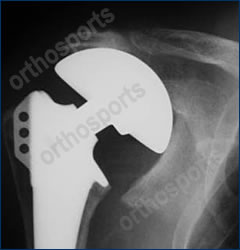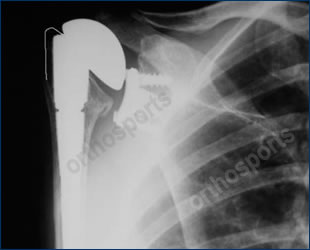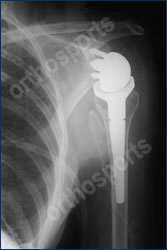Inside This section
Reverse Shoulder Replacement
Total shoulder replacement is very effective at restoring function and reducing pain for arthritis of the shoulder. There is a humeral (arm bone) and a glenoid (wing bone) component which are not linked. Unlike hip replacement, shoulder replacement relies almost entirely on muscle action to provide stability to the implant. Please read the section on Total Shoulder Replacement prior to reading this section.
Stability of the ball and socket part of the shoulder joint is provided by the rotator cuff muscles, so patients with damage to this group of muscles in the past were not be able to undergo prosthetic joint replacement. Historically this left a large number of patients who developed glenohumeral (shoulder) arthritis as a result of a rotator cuff tear with few, if any, salvage options.

X-Ray of Arthritic Shoulder

Historical Treatment With Half Shoulder Replacement
In a normal shoulder the deltoid (top shoulder muscle) pulls the humerus superiorly (upwards) while the rotator cuff balances the pull inferiorly (downwards). The cuff also initiates forward elevation and abduction (sideways) movement of the shoulder before the deltoid takes over and completes the movement. When the rotator cuff is torn the humeral head is pulled upwards only and ‘escapes’ anteriorly and superiorly (out the front). Traditionally this was treated with a hemiarthroplasty (half shoulder replacement) which reduced pain for a period of time but did not restore function. Total shoulder replacement fails rapidly and should not be performed in patients with rotator cuff tears.

X-Ray of Dislocating Total Shoulder Replacement
The first reverse shoulder replacements were performed in the 1970’s and had many problems. Many lessons were learned from this and design modifications were undertaken to change the centre of rotation of the shoulder joint to allow the deltoid to provide movement and stability for the prosthesis and bypass the rotator cuff. The complication rate of this operation is now low when performed by experienced surgeons. For difficult cases, Surgeons are now able to use computerised patient specific instrumentation, where a computer designs specific instruments based on a CT scan of the patient , that allows the surgeon to place the components of the replacement in exactly the correct position.

X-Ray of Reverse Shoulder Replacement
Reverse shoulder replacement is now an excellent alternative for patients with rotator cuff arthropathy (arthritis from their rotator cuff tear) or other conditions where there is failure of a total shoulder replacement or where the shape of the socket of the shoulder is abnormal due to previous surgery or a congenital deformity. Use of the arm is started several weeks after the procedure and extensive therapy is usually not needed with reverse shoulder surgery.
It is important to note that this procedure does not restore the ability of the shoulder to perform heavy work or sport.
